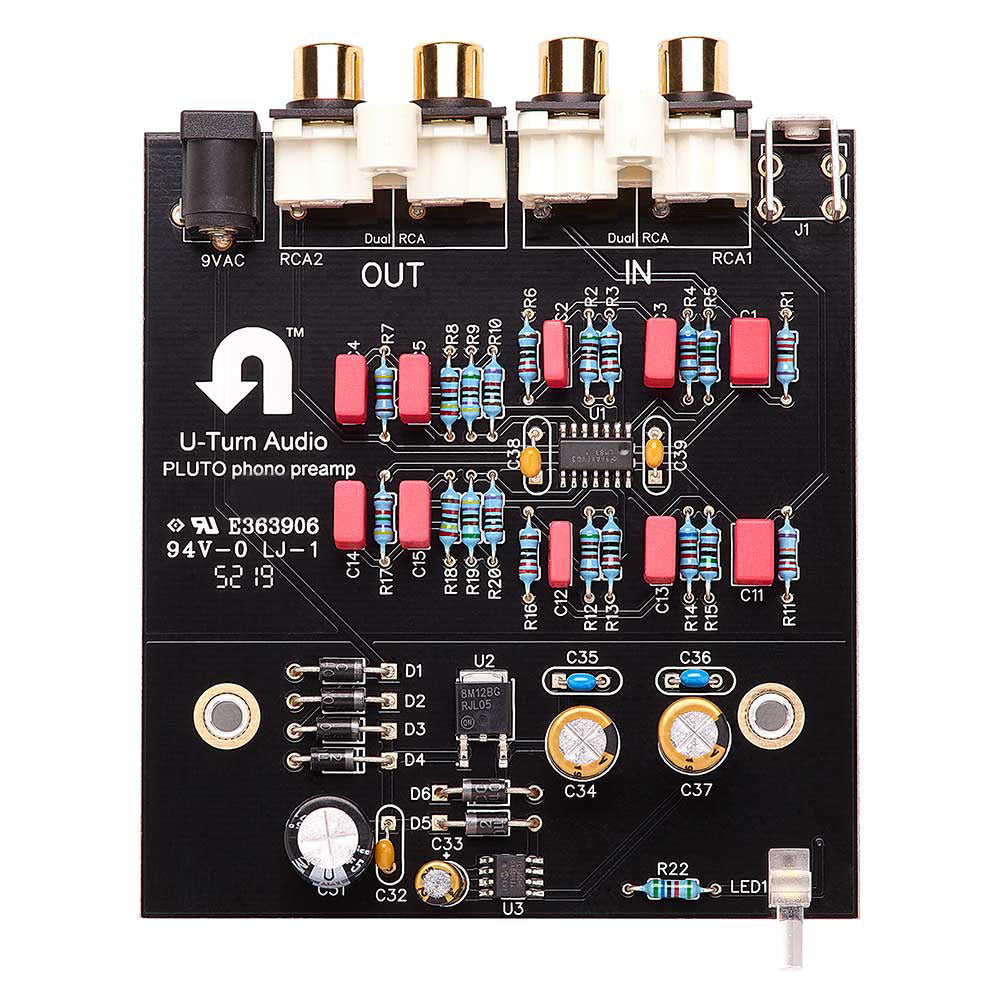This is a review and detailed measurements of the U-Turn Audio Pluto 2 phono stage (preamplifier). It was kindly purchased new by a member and drop shipped to me for testing. It costs US $99 from dealers.
The Pluto 2 comes in a nicely done and solid meta box:

It only supports moving magnet input so there is nothing to select.
Inputs and outputs as you can imagine then, is very simple:

Power is provided by the 9 volt AC transformer (NOT DC power). This makes the design simpler as you can covert AC to plus and negative voltages very easily which can then drive the amplifier.
Internal layout is nice and clean:

The power supply is on the bottom which requires routing of the AC power past the amplifier. This may cause some extra hum that would not be there otherwise. Don't understand why SMD parts were not used for passive parts. Perhaps it would not look so pretty in the picture!
U-Turn Audio Pluto 2 Measurements
As usual, we start with our dashboard with driving the unit at 5 millivolts @ 1 kHz:

Gain is 40 dB. Spectrum of noise and distortion shows that we are limited by the mains hum at -80 dB. By playing with grounding, I reduced it a couple of dB as you see. No further reduction of it was possible in my setup making me think what is there is ripple from the power supply. That sets our noise floor which as noted, is much more than distortion. SINAD as a result is dominated by that hum:

Still, that is above average.
We can confirm the signal to noise ratio by measuring it independent of distortion:

We see that we are a bit shy of the company spec when we apply a-weighting so maybe that hum can be further reduced.
Distortion as noted is quite low:

Sweeping the frequency we see that distortion remains low and is most optimized for 2 to 5 kHz which is nice:

Testing for overload we see that you need to get to > 55 mv input before the amp clips:

We have seen better and worse.
Most important test here is faithfulness of RIAA equalization and the Pluto 2 does well there:

Conclusions
For a budget product, I like to see a solid build with distortion below noise and correct RIAA equalization. Pluto 2 delivers on that. It is a simple story and it works.
I am putting the U-Turn Audio Pluto 2 on my recommended list.
------------
As always, questions, comments, recommendations, etc. are welcome.
Appreciate any donations using: https://www.audiosciencereview.com/forum/index.php?threads/how-to-support-audio-science-review.8150/
The Pluto 2 comes in a nicely done and solid meta box:
It only supports moving magnet input so there is nothing to select.
Inputs and outputs as you can imagine then, is very simple:
Power is provided by the 9 volt AC transformer (NOT DC power). This makes the design simpler as you can covert AC to plus and negative voltages very easily which can then drive the amplifier.
Internal layout is nice and clean:

The power supply is on the bottom which requires routing of the AC power past the amplifier. This may cause some extra hum that would not be there otherwise. Don't understand why SMD parts were not used for passive parts. Perhaps it would not look so pretty in the picture!
U-Turn Audio Pluto 2 Measurements
As usual, we start with our dashboard with driving the unit at 5 millivolts @ 1 kHz:
Gain is 40 dB. Spectrum of noise and distortion shows that we are limited by the mains hum at -80 dB. By playing with grounding, I reduced it a couple of dB as you see. No further reduction of it was possible in my setup making me think what is there is ripple from the power supply. That sets our noise floor which as noted, is much more than distortion. SINAD as a result is dominated by that hum:
Still, that is above average.
We can confirm the signal to noise ratio by measuring it independent of distortion:
We see that we are a bit shy of the company spec when we apply a-weighting so maybe that hum can be further reduced.
Distortion as noted is quite low:
Sweeping the frequency we see that distortion remains low and is most optimized for 2 to 5 kHz which is nice:
Testing for overload we see that you need to get to > 55 mv input before the amp clips:
We have seen better and worse.
Most important test here is faithfulness of RIAA equalization and the Pluto 2 does well there:
Conclusions
For a budget product, I like to see a solid build with distortion below noise and correct RIAA equalization. Pluto 2 delivers on that. It is a simple story and it works.
I am putting the U-Turn Audio Pluto 2 on my recommended list.
------------
As always, questions, comments, recommendations, etc. are welcome.
Appreciate any donations using: https://www.audiosciencereview.com/forum/index.php?threads/how-to-support-audio-science-review.8150/
